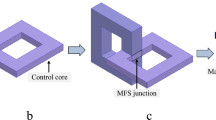Abstract
Power converters are increasingly being operated at switching frequencies beyond 1 MHz to reduce energy storage requirements and passive component size. To achieve this miniaturization, designers of inductors and transformers need magnetic materials with good properties in the MHz regime. In this paper, we argue that available materials are not optimized for MHz power conversion applications—even those that are marketed as such—and that further development of magnetic materials is needed. In particular, we review how magnetic components are used in power converters and demonstrate that reducing core loss should be the main target of future material development, as existing permeabilities and saturation flux densities are substantially higher than necessary. The progress of power conversion technology will depend in part on how well new magnetic materials can be optimized—properly—for the MHz regime.
Graphical abstract










Similar content being viewed by others
Notes
Most students have learned in electromagnetics that larger \(N\) leads to more B field. This is true, all else equal. In design, however, the target inductance is usually fixed and larger \(N\) is necessarily accompanied by larger reluctance \(\mathcal{R}\). Because gap length must scale more than \(N\) to maintain inductance \(\left(L\propto \frac{{N}^{2}}{\mathcal{R}}\right)\), the B field in the resulting structure is actually smaller. This result is captured more directly in (2).
The choice of notation for performance factor is fraught. Script \(\mathcal{P}\) is commonly used for permeance, script \(\mathcal{F}\) is commonly used for magnetomotive force, and PF is commonly used for power factor. Both \(\mathcal{F}\) and PF have been used for performance factor in the literature; we opt for \(\mathcal{F}\) because the abbreviation MMF is readily available for magnetomotive force.
Another class of components likely to be saturation-limited are pulsed components, i.e. those that are expected to carry very high current for a short amount of time. We only consider continuously-operated components in this paper.
Core loss density would be unaffected; technically the core volume is negligibly smaller when the gap length is increased, which leads to a negligible decrease in total core loss.
Higher component quality factors are almost always desirable, hence the lower limit on typical values. The upper limit comes partly from feasibility and partly from the diminishing returns on having extremely low losses in the magnetic component compared to other components in the system.
References
B.D. Cullity, C.D. Graham, Introduction to Magnetic Materials (Wiley, New York, 2009)
D. Jiles, Introduction to Magnetism and Magnetic Materials (CRC Press, Boca Raton, 2016)
C.P. Steinmetz, On the law of hysteresis. Trans. Am. Ins. Electr. Eng. IX(1), 1–64 (1892)
K. Venkatachalam, C.R. Sullivan, T. Abdallah, H. Tacca, Accurate prediction of ferrite core loss with nonsinusoidal waveforms using only Steinmetz parameters, in IEEE Workshop on Computers in Power Electronics (2002)
R.W. Erickson, D. Maksimovic, Fundamentals of Power Electronics (Springer, Cham, 2020)
J.G. Kassakian, M.R. Schlecht, G.C. Verghese, Principles of Power Electronics (Pearson, London, 1991)
W.G. Hurley, W.H. Wolfle, Transformers and Inductors for Power Electronics (Wiley, New York, 2013)
T.G.W. Stijntjes, Power ferrites: Performance and microstructure, in International Conference on Ferrites 5 (1989)
S.A. Mulder, Fit formulae for power loss in ferrites and their use in transformer design, in Proceedings of the International Power Conversion Conference (1993)
A. Goldman, Modern Ferrite Technology (Springer, Berlin, 2006)
A.J. Hanson, J.A. Belk, S. Lim, C.R. Sullivan, D.J. Perreault, Measurements and performance factor comparisons of magnetic materials at high frequency. IEEE Trans. Power Electron. 31(11), 7909–7925 (2016)
R.S. Yang, A.J. Hanson, B.A. Reese, C.R. Sullivan, D.J. Perreault, A low-loss inductor structure and design guidelines for high-frequency applications. IEEE Trans. Power Electron. 34(10), 9993–10005 (2019)
R.S. Yang, A.J. Hanson, C.R. Sullivan, D.J. Perreault, Design flexibility of a modular low-loss high-frequency inductor structure. IEEE Trans. Power Electron. 36(11), 13013–13024 (2021)
A. Nguyen, A. Phanse, M. Solomentsev, A.J. Hanson, A low-leakage, low-loss magnetic transformer structure for high-frequency applications, in EPE 2022 ECCE Europe, Hanover (to appear) (2022)
B.A. Reese, C.R. Sullivan, The effect of permeability on magnetic core performance factors, in IEEE Workshop on Control and Modeling for Power Electronics (COMPEL) (2017)
U. Reggiani, G. Grandi, G. Sancineto, G. Serra, Comparison between air-core and laminated iron-core inductors in filtering applications for switching converters, in IEEE International Power Electronics Congress (CIEP), Acapulco, Mexico (2000)
R.T. Naayagi, A.J. Forsyth, Design of high frequency air-core inductor for DAB converter, in IEEE International Conference on Power Electronics, Drives and Energy Systems, Bengaluru, India (2012)
S. Mao, C. Li, T. Song, J. Popovic, J.A. Ferreira, High frequency high voltage generation with air-core transformer, in International Workshop on Integrated Power Packaging (IWIPP) (2017)
S.R. Meher, D. Gautam, R. Singh, Wireless power transfer using EF2 inverter with fixed coil capacitor and air core inductor, in IEEE Applied Power Electronics Conference and Exposition (2020)
Z. Tong, W. Braun, J. Rivas, Design and fabrication of three-dimensional printed air-core transformers for high-frequency power applications. IEEE Trans. Power Electron. 35(8), 8472–8489 (2020)
A.S. Jurkov, A. Radomski, D.J. Perreault, Tunable matching networks based on phase-switched impedance modulation. IEEE Trans. Power Electron. 35(10), 10150–10167 (2020)
W. Liang, L. Raymond, J. Rivas, 3-D-printed air-core inductors for high-frequency converters. IEEE Trans. Power Electron. 31(1), 52–64 (2016)
M. Solomentsev, A.J. Hanson, At what frequencies should air-core magnetics be used?, in IEEE Applied Power Electronics Conference and Exposition (APEC), Houston, (2021)
R.S. Bayliss, R.S. Yang, A.J. Hanson, C.R. Sullivan, D.J. Perreault, Design, implementation, and evaluation of high-efficiency high-power radio-frequency inductors, in IEEE Applied Power Electronics Conference and Exposition (APEC) (2021)
Funding
This work is not related to any funded research.
Author information
Authors and Affiliations
Corresponding author
Ethics declarations
Conflict of interest
There is no conflict of interest.
Rights and permissions
Springer Nature or its licensor holds exclusive rights to this article under a publishing agreement with the author(s) or other rightsholder(s); author self-archiving of the accepted manuscript version of this article is solely governed by the terms of such publishing agreement and applicable law.
About this article
Cite this article
Hanson, A. Opportunities in magnetic materials for high-frequency power conversion. MRS Communications 12, 521–530 (2022). https://doi.org/10.1557/s43579-022-00225-1
Received:
Accepted:
Published:
Issue Date:
DOI: https://doi.org/10.1557/s43579-022-00225-1




